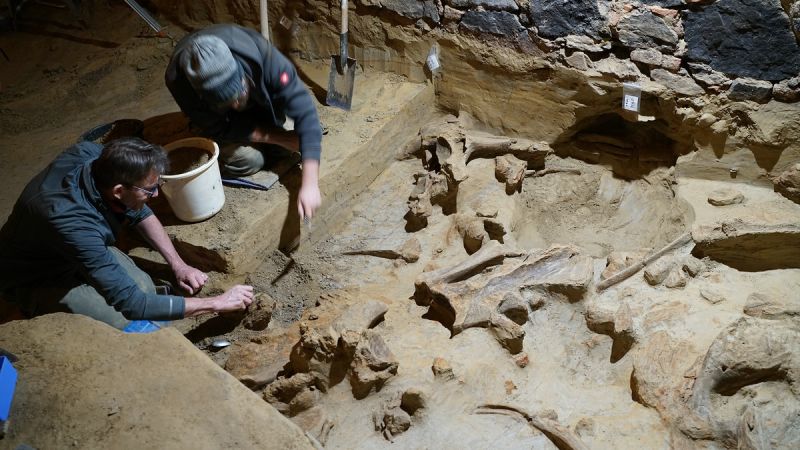CNN
—
Hundreds of mammoth bones have been uncovered in an Austrian wine cellar, in a discovery labelled an “archaeological sensation.”
The remains are thought to be between 30,000 and 40,000 years old, according to experts.
Andreas Pernerstorfer made the incredible discovery while renovating his wine cellar in the village of Gobelsburg, about 70 kilometers (43 miles) northwest of Vienna, in March.
The find has been described as the most significant of its kind in more than a century, with researchers from the Austrian Academy of Sciences (OeAW), who are now recovering the bones, describing it as an “archaeological sensation,” according to a Wednesday press release.
Pernerstorfer had decided to carry out some work to level the floor in the cellar, archaeologist Hannah Parow– Souchon, a researcher at the OeAW, told CNN in a video call Thursday.
“He wanted to level the floor of his wine cellar because it was sloping and he removed some concrete in the center,” she said.
“More or less immediately he found the bones, which he initially thought were wood. Then he looked more closely and remembered a tale from his grandfather who in the sixties extended the cellar and found some mammoth molars.”
Pernerstorfer reported the find to the Federal Monuments Office, which referred him to the OeAW because, as Parow-Souchon told CNN, “we are experts on the Stone Age.”
She and her team of fellow archaeologists embarked on an excavation at the start of May. “It quickly became apparent that it wasn’t just a few mammoth bones but very many mammoth bones,” she said.
Parow-Souchon said they have “at least 300 bones,” which were found densely packed together.
H. Parow-Souchon/OeAW-OeAI
The excavated area is relatively small so the team hope to return later this summer to continue with their investigation.
“We think we have mostly the complete animals. They’re not in anatomical connection but we do have probably all parts,” she said, adding that the recovered haul includes some rare finds, including a lingual (tongue) bone.”
The archaeologists believe the bones are from three separate mammoths. The site they excavated was just 12 square meters (129 square feet) big, but they are hoping to return in August to continue with their search.
“I love being an archaeologist. I’ve excavated lots of exciting things but I always wanted to excavate a mammoth,” said Parow-Souchon, adding that the mammoth bone discovery was a first for her. “I’m thrilled, I can’t deny it,” she said.
H. Parow-Souchon/OeAW-OeAI
More than 300 densely packed bones were discovered, though there are likely to be considerably more buried beneath the cellar.
Comparable sites elsewhere in Austria and in neighboring countries were mostly excavated more than 100 years ago, which means they are not available for modern research.
“It’s the first time we’ve been able to investigate something like this in Austria using modern methods. It is a unique opportunity for research,” said Parow-Souchon in the press release.
The excavations, funded by the Federal Monuments Office and the province of Lower Austria, raise many questions, including whether these animals were killed by Stone Age hunters.
“We know that humans hunted mammoths, but we still know very little about how they did it,” said Parow-Souchon, adding that a trap for the animals may have been set at this site.
Once the researchers complete their work, the bones will be passed to the Natural History Museum Vienna for restoration.
Sign up for CNN’s Wonder Theory science newsletter. Explore the universe with news on fascinating discoveries, scientific advancements and more.








:max_bytes(150000):strip_icc()/roundup-writereditor-loved-deals-tout-f5de51f85de145b2b1eb99cdb7b6cb84.jpg)


